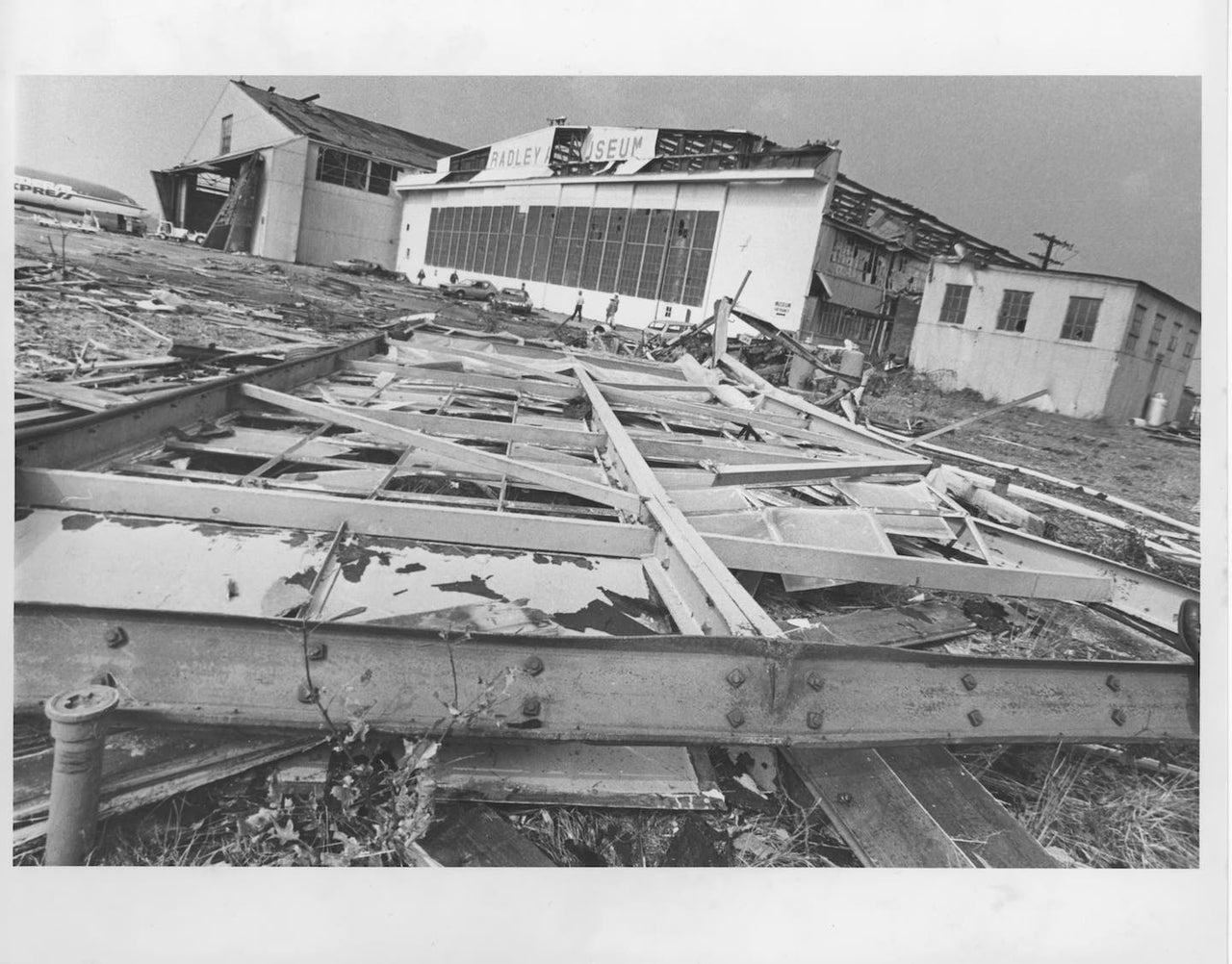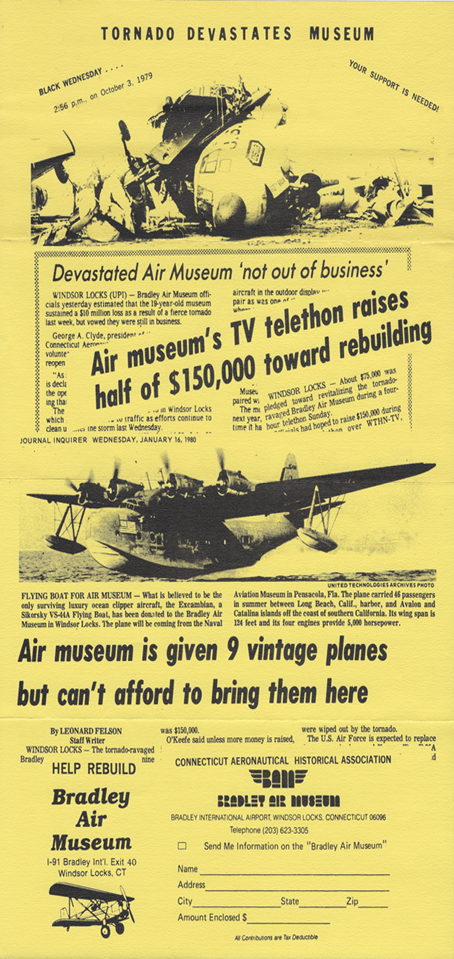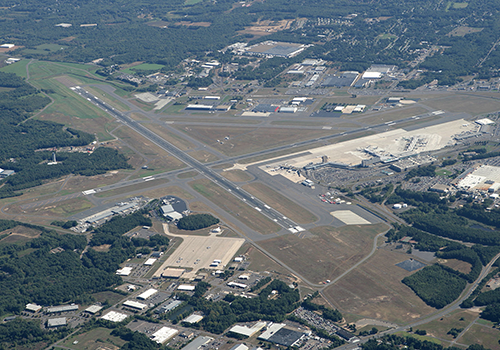JUST BEFORE 3 PM ON OCTOBER 3, 1979, AN F4 TORNADO TOUCHED DOWN IN NORTH-CENTRAL CONNECTICUT. IN LESS THAN 10 MINUTES, IT CARVED A PATH OF DESTRUCTION 11 MILES LONG THROUGH WINDSOR, WINDSOR LOCKS, AND SOUTHERN MASSACHUSETTS. OUR MUSEUM, KNOWN BACK THEN AS BRADLEY AIR MUSEUM, TOOK A DIRECT HIT.

The Destruction of a Museum
1979 Windsor Locks Tornado
From humble beginnings in the early 1960s, the Bradley Air Museum (BAM) had grown from a mere idea to a professional operation. By the time of the tornado, it was thought to have the fourth-largest collection of its kind in the country, with approximately 120 historic aircraft on display and in storage.
Back then, the museum was located on the other side of the airport just off Route 75. The 4.5-acre outdoor display yard showcased bombers, transports, helicopters and a few smaller aircraft. Just a few minutes down the road, a 24,000 square-foot hangar dating from the Second World War housed the rest of the viewable collection.
In early 1979 it was announced that the land the museum occupied was needed for the airport’s continued expansion. The museum would be moved to a new 58-acre location on the western side of the airport (where we are now).
By October, the museum had completed work on an ambitious new Master Plan for a multimillion-dollar complex at the new location, with spaces for exhibits, indoor and outdoor aircraft displays, and restoration facilities. With attendance increasing and a long-term plan for the museum’s growth and success in place, staff and volunteers were optimistic and excited for what 1980 would bring.
The weather on October 3, 1979 was cloudy and drizzly, but not out of the ordinary. Tornadoes were the last thing on anyone’s mind, as they almost never occurred this late in the year. The National Weather Service office at the airport issued a severe thunderstorm warning but said nothing about the unforeseen tornadoes that were formed by unusual conditions.
Once spawned, the tornado moved quickly into Poquonock, a village in the northern area of Windsor. All three of the tornado’s fatalities occurred in this area. The tornado, which grew to be almost 1,400 yards wide, gathered strength as it moved north towards the airport, with the Bradley Air Museum in it's direct path.
In just a few minutes, it was all over. Of the 30 aircraft in the outdoor display, only 4 escaped serious damage. Of the remainder, 16 were destroyed, and 10 were deemed damaged but salvageable. The roof of the display hangar was torn to pieces, with numerous aircraft inside also substantially damaged.
The tornado continued its northerly course but retracted back into the clouds soon after. Before dissipating completely, however, it touched down at least once more in Feeding Hills, Massachusetts, causing significant damage there as well.
THE
AFTERMATH
Despite the shock of what had just occurred, cleanup efforts began almost immediately after the tornado disappeared.
At the museum, The outdoor yard was a heap of twisted metal, their hangar was unusable, and almost all the surviving aircraft needed some level of repair work. Revenue from admissions—BAM’s primary source of income—would be nonexistent for the foreseeable future. A fundraising campaign was launched, but this money would only be enough to cover short-term operating costs; the museum still had to raise the funds to build a new facility at their new location.
While museum leadership figured out how to afford a new home, they also worked to reopen temporarily and show the public that BAM was not out of business. Once the outdoor display had been cleaned up enough to be safe, it was reopened on weekends (weather permitting), with visitors paying 99 cents to view the storm-damaged aircraft.
Eventually a 2-acre site located behind the old hangar was secured. Fencing was installed and twenty-five aircraft were set up as a temporary outdoor display, which opened to the public in June of 1980.
Meanwhile, fundraising efforts continued. In early 1981 the museum secured a $750,000 disaster assistance loan through the Small Business Association, and ground was broken on the new site.

A New Museum
FALL 1981

Two years to the day after it nearly met its end, the Bradley Air Museum opened its new hangar to the public. Alongside the many tornado survivors on display inside the 35,000 square-foot space were several new additions, including some replacements for aircraft lost during the storm. There was still plenty of work to be done, but after more than 20 years, the museum had finally fulfilled an important goal: acquiring a permanent home for its collections and building a permanent exhibition building in which to display them.
Although today the airport, museum, and communities affected by the Windsor Locks tornado—which ultimately killed 3 people, injured hundreds more, and caused hundreds of millions of dollars in damage—bear few visible scars, those who survived its wrath won’t soon forget the memory of that day. Since reopening in 1981, the museum (later renamed the New England Air Museum) has built new hangars, grown its collections, and fully repaired several planes that suffered significant damage during the tornado, including the B-29 Superfortress, B-25 Mitchell, and F-104C Starfighter.
Now restored to their former glory, these aircraft stand as silent witnesses to one of the worst severe weather events in Connecticut’s history, and a testament to the hard work of our predecessors who persevered and ensured that the museum did not close for good on October 3, 1979.



